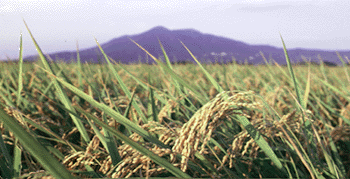
(permission pending) Photo courtesy of http://rgp.dna.affrc.go.jp/.
|
|
|
|

(permission pending) Photo courtesy of http://rgp.dna.affrc.go.jp/. |
| Rice as a Food Staple
The sequencing of the rice genome is a project of international interest due to rice's status as a world food staple. Completing the rice genome will allow for future advancements in genetically modifying the organism in oder to increase worldwide yield or protect the plant from disease or parasitic infection. Making rice easier ad more productive to grow by the insertion of foreign genes or modification of rice genes could help ease the hunger of millions of people in developing countries around the world. |
| Rice as a Model Organism for Other Grass Species
Rice belongs to the grass
family, Gramineae, which also includes other agriculturally important
species such as sorghum, wheat, barley, rye, and maize (US Rice Genome
Sequencing). All of the members of this family have very similar
genetic characteristics. Rice has the easiest genome to sequence
due to several factors, including the smallest genome of in the family
Graminae,so
the information gained from the seqeuncing of the rice genome may be used
to help understand many of the other members of family
Graminae
(US
Rice Genome Sequencing). Gene structure and function for rice,
as well as many other species, will be better understood as a result of
the sequencing which will allow for improvements to be made in the way
crops grow, use energy, and fight disease. Thus, the information
gained from sequencing a single genome increases.
|
| rGenome Sequencing Progress
The rice genome is fairly
small, approximately 430 Mb in length (US Rice Genome Sequencing).
Due to the managable size of the genome, it should not be long before the
sequencing project is complete. As of September 9th, scientists at
the internation consortium, The Rice Genome Project, had made 223,502,742
base pairs of the rice genome available to the public (The Rice Genome
Research Project). It is expected that the project will be finished
in the next several months.
|
| IHow the Rice Genome is Being Sequenced
While the task of sequencing the genome of an organism is a highly technical and time consuming task, an attempt to convey the methods used by The Rice Genome Project to sequence rice's genome has been included below (The Rice Genome Research Project). The primary method, called the shotgun method, is the basis for this flowchart. |

|
|
US Rice Genome Sequencing. 5 September 2002. www.usricegenome.org/ |
|
The Rice Genome Research Project: One of the leaders in the sequencing of the rice genome. http://rgp.dna.affrc.go.jp/ The Rice Web: "A compendium of facts and figures from the world of rice." http://www.riceweb.org/Index.htm US Rice Genome Sequencing: Includes a link that allows
you to perform a blast search of specific genes on chromosomes 3 through
11. www.usricegenome.org/
|
|
|
|
Send comments, questions, and suggestions to: lahalpin@davidson.edu |